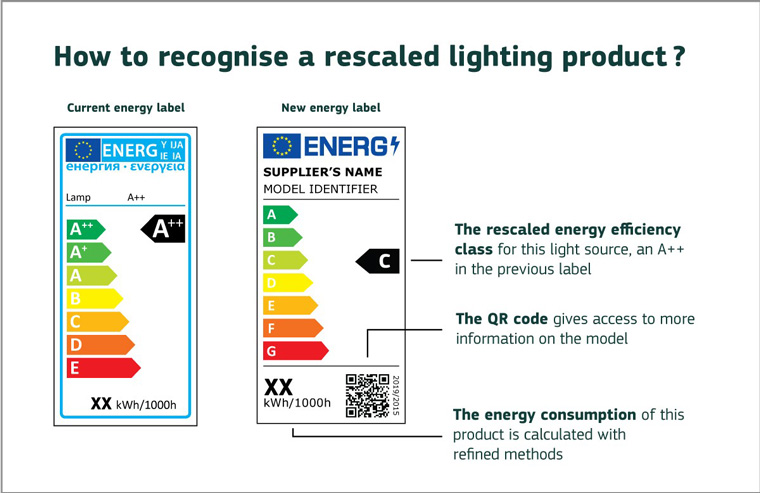BRUSSELS — To help EU consumers cut their energy bills and carbon footprint, a brand new version of the widely-recognized EU energy label for light bulbs and other lighting products will be applicable in all shops and online retail outlets from Wednesday, 1 September 2021. The move follows the considerable improvement in energy efficiency in this sector in recent years, which has meant that more and more “light sources” (such as light bulbs and LED modules) have achieved label ratings of A+ or A++ according to the current scale. The most important change is the return to a simpler A-G scale.
EU Energy Commissioner Kadri Simson said: “Our lamps and other lighting products have become so much more efficient in the recent years that more than half of LEDs are now in the A++ class. Updating the labels will make it easier for consumers to see what are the ‘best in class’ products, which in turn will help them to save energy and money on their bills. Using more energy efficient lighting will continue to reduce the EU greenhouse gas emissions and contribute to becoming climate-neutral by 2050.”
The new scale is stricter and designed so that very few products are initially able to achieve the “A” and “B” ratings, leaving space for more efficient products to gradually enter the market. The most energy efficient products currently on the market will typically now be labeled as “C” or “D”. A number of new elements will be included on the labels, including a QR code that links to an EU-wide database, where consumers can find more details about the product.
In order to allow for the sale of existing stock, the rules provide for an 18-month period where the products bearing the old label can continue to be sold on the market in physical retail outlets. For online sales, however, the old labels displayed online will have to be replaced by the new ones within 14 working days.
Today’s measures follow a rescaling of the energy labels on 1 March 2021 for 4 other product categories – fridges and freezers, dishwashers, washing machines, and televisions (and other external monitors). Building on EU ecodesign rules, the European Commission is also working on updating the labeling for products including tumble dryers, local space heaters, air conditioners, cooking appliances, ventilation units, professional refrigeration cabinets, space and water heaters, and solid fuel boilers, and considering the introduction of new energy labels for solar panels.

Background
Light source technologies keep evolving, thereby improving energy efficiency. LED modules, which are for almost all applications the most energy efficient lighting technology that exists, have had a rapid uptake on the EU market: from 0% of lamps sold in 2008 to 22% in 2015. The average energy efficiency of LEDs quadrupled between 2009 and 2015, and prices dropped significantly: compared to 2010, in 2017 a typical LED lamp for household use was 75% cheaper and a typical LED lamp for offices 60% cheaper.
It is estimated that approximately 1500 million light sources were sold in the EU in 2020 – but this figure is likely to fall to 600m in 2030 (i.e. down 60%), even though the number of light sources used will rise by more than 17%. This is because of the greater energy efficiency and in particular the longer lifetime of LED light sources. The average household in the EU bought 7 light sources per year in 2010, 4 per year in 2020, and this figure is projected to drop to less than 1 per year by 2030.
The Commission’s impact assessment of the new rules indicates that the changes will save 7 million tonnes of CO2 equivalent (mtCO2eq) a year by 2030, relative to a business as usual scenario without any EU eco-design measures. This comes in addition to the 12mtCO2eq already provided by the previous regulations adopted in 2009 and 2012.
The new categories for the rescaled label were agreed after a rigorous and fully transparent consultation process, with the close involvement of stakeholders and Member States at all stages, and scrutiny by the Council and the European Parliament – and with sufficient notice provided to manufacturers with the new rules agreed in 2019. As required by the framework regulation, other product groups will be “rescaled” in the coming years – including tumble dryers, local space heaters, air conditioners, cooking appliances, ventilation units, professional refrigeration cabinets, space and water heaters, and solid fuel boilers.
The EU energy label is a widely recognized feature on household products, like light bulbs, televisions or washing machines, and has helped consumers make informed choices for more than 25 years. In an EU-wide (Eurobarometer) survey in 2019, 93% of consumers confirmed that they recognized the label and 79% confirmed that it had influenced their decision on what product to buy. Together with harmonized minimum performance requirements (“ecodesign”), EU energy labeling rules are estimated to cut consumer expenditure by tens of billions of euros every year, whilst generating multiple other benefits for the environment and for manufacturers and retailers.
Tagged with Europe, lightED